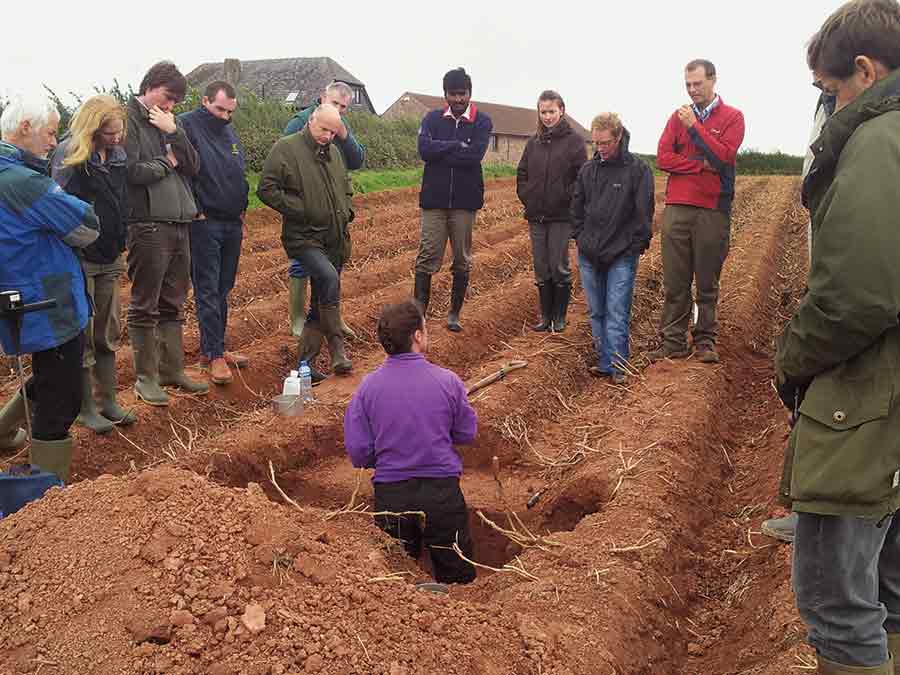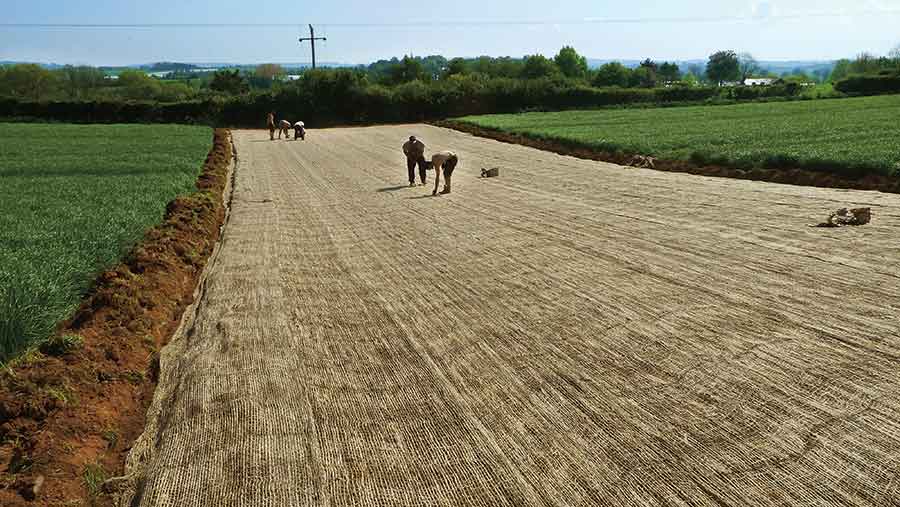Landowners tackle soil health in tenancy deals
Scientists have warned the UK has only 100 harvests left in its soils due to intensive farming. Perhaps it is no surprise then that landlords are beginning to address soil health in tenancy agreements.
Soil is the building block of all farming and critical to biodiversity. Yet scientists have warned that basic nutrients are in sharp decline across vast tracts of agricultural land.

© Tim Scrivener
Against a backdrop of price volatility and climate change, issues such as soil compaction, erosion, flooding and declining levels of organic matter and soil nutrients have all become more important.
See also: Only 100 harvests left in UK farm soils, scientists warn
The United Nations declared last year the International Year for Soils and earlier this year, the Soil Association warned action was needed if the UK was to retain its long-term ability to produce food.
Questions to ask your landlord
If soil health is included in your tenancy agreement, there are a few questions you might want to ask your landlord:
Can you see base figures for the farm?
On what basis are the calculations made?
What was the size of sample?
What was the weather like when the sample was taken?
On what date and time of day was the sample taken?
Who has control of testing when your tenancy ends?
Will tests be carried out on a like-for-like basis?
Who pays for testing?
Is there a force majeure clause? (This would exempt a party from meeting certain targets on time in the event of extraordinary events such as freak weather)
As a result of greater focus on the issue, landlords are increasingly starting to look at ways of encouraging tenants to improve the resilience and health of the soils they farm. But what are they doing, how and why?
The Crown Estate approach
With many tenants on farm business tenancies (FBTs) of five years or less, there has long been debate about how to tackle the problem of those who focus on short-term returns rather than long-term sustainability.
The Crown Estate, which owns 106,000ha across the UK, has sought to tackle the problem head on by becoming one of the first institutional landlords to introduce a soil-testing regime as part of all new tenancy agreements.
Ken Jones, director of the rural and coastal portfolio, says addressing soil management is a “no-brainer” for a commercial organisation taking a long-term view of its asset base in order to preserve its value.
He also believes it is in the interests of tenants who are safeguarding both the quality and the yield of the crops they produce.
Measuring baseline soil standards
Under its “Project Soil” programme, the Crown Estate has introduced a clause in all new FBTs that require the tenant to maintain and where possible improve the soil. The first of these agreements was put in place two years ago.
Prior to any new tenancy, soil samples are taken from every field by precision farming company SOYL to assess levels of nutrients such as N, P & K, as well as pH, soil structure and organic matter.
The costs of the tests and the data produced are shared 50:50 between the business and the incoming tenant.
“What it gives is a baseline that tenants mustn’t go below,” says Mr Jones. “It is a little like carrying out an inventory before someone goes into a flat.”
If soil tests at the end of the agreement show that indices have fallen, the tenant is effectively required to pay for putting the land back into the condition it was at the start of the tenancy.
But Mr Jones says the goal is not to get to that point and the estate offers workshops to all tenants that look at best-practice soil management.
Getting contractual details right
Emma Folkes, legal direct at solicitor Burges Salmon, has been working with the Crown Estate on making soil health a part of their tenancy agreements.
Particular terms are included in the contracts to ensure every party is clear on the approach to soil monitoring, she says. These include:
- Definitions of soil reports and specified targets based on structure, nutrient profile and other indicators.
- Tenant repairing covenant to leave soil in no worse a condition than commensurate with a specified target.
- A mid-term and outgoing soil test must be conducted and the landlord has the right to carry out mid-term tests if tenant fails to.
- The soil data collected is preserved so there is a clear history.
- Details setting out the sharing of costs of incoming and outgoing soil testing.
“If outgoing soil tests reveal that the soil conditions fall short of the specified targets, that is a dilapidation and is treated in the same way as others,” says Ms Folkes.
Addressing this might involve calculating the cost of putting the soil back into a condition that meets the targets in the agreement.
“The intention is for it to be in both the landlord’s and tenant’s interests for the soil measures to be met, as that maximises productivity and protects the vigour of the land,” says Ms Folkes.
“So the aim is very much for the relationship between landlord and tenant to be a partnership – and for the issue of adherence to the tenant’s covenants to be largely self-regulatory.”
Incentives for improving soil quality
At the moment, there is no financial incentive for a tenant to improve the soil beyond the baseline, but this is the next goal.
The estate is working with the Central Association of Agricultural Valuers (CAAV) to work out the right approach for rewarding people who add value to the soil.
“The powers that be, in terms of deciding how you value soil quality, haven’t yet come up with the right metrics to give us that answer,” says Mr Jones.
“So at the moment [the agreement] is protective, but we do hope to develop it so it can be more positive and we can put carrots in place as well as sticks.”
This could be at least two years away and there could be several different iterations before they hit on the right way to deliver this. “It is a work in progress, butwe have to start somewhere.”
Changes to the FBT tendering process
As soil management becomes increasingly important, it is changing the way the estate selects successful bidders, says Mr Jones.
Bid ranking not only rests on the rent offered, but also the strength of the soil management plan, which is also required as part of a tender.
In all of the tenancies (about 10) that have come up since the new scheme was introduced, it has been the farmer with the best soil management plan who has won the land, he says.
This means they have turned down higher offers of rent in favour of an applicant who has produced a better soil plan.
AHA tenancies and soil
The Agricultural Holdings Act 1986 has been reformed recently to update the provisions for compensation for tenants at the end of an agreement.
Schedule 8 has been updated so tenants can be compensated for improvements made to the holding through the use of manure, soil improvers and digestate, not just purchased manure and fertiliser.
The aim is to give outgoing tenants an incentive to farm sustainability and leave the soil in good condition for incoming tenants.
“It is not to say that this is a charitable exercise, because they were commercial rent offers, but they certainly weren’t the highest offers.”
Other landlords’ approach
The Crown Estate may be the most high-profile landlord taking this approach, but according to agents, the use of soil indices clauses in agreements is becoming more common than it was five or 10 years ago. There is also lots of talk about others going down a similar path.
Rob Mackin, head of farming at the National Trust, says it is not something the charity has introduced into its tenancies yet.
“However, as a first step we have started to score soil condition across our properties and we will increasingly consider factors affecting soil health as part of our future letting procedures.”
The Duchy of Cornwall Estate says it has been working with its tenants on soil issues (see panel) but has not made a decision on whether to include it more formally in agreements.
The critic’s view
George Dunn, chief executive of the Tenant Farmers Association, says he absolutely agrees that soil quality is a major issue.
But he argues including soil monitoring in FBTs is dealing with the symptoms, rather than the cause and giving people longer-term security would be one of the best ways of encouraging them to invest in soil management.
“Where we have seen a shift from long-term security to having security of, say, three years, why would someone invest in lime, soil improvers and organic matter?” he argues.
Mr Dunn says taking nutrient measurements over a relatively short period could also prove to be meaningless.
“We know from year to year on the same parcel of land you could have massive amounts of trace elements one year and then low amounts the next.
“Measuring over two points that are not very far apart on a short-term FBT doesn’t give you an adequate view of what is happening with that soil. Looking at it over a 10- to 15-year period, you would be able to get a better view.”
A time of experimentation
Jeremy Moody of the CAAV stresses the use of such agreements is at an “experimental stage”. While measuring and valuing certain indices might be a well-trodden path, there are others such as soil organic matter that are new terrain.
As agreements come to an end, it will be important to look at what works, what doesn’t and how to draft the next agreement better, he says.
Mr Moody says one of the problems in coming up with a system for penalties and incentives is that things that are generally regarded as true about soil science might not be quite as true in detail. And that poses practical questions once you start to apply legal requirements and monetary values.
Tenants considering such an arrangement should consider if what they are being asked to do is realistic and how to allow for things that are outside their control.
“For example, if you are looking at somewhere with repeated flooding, or if one or two of your tenancy years are subject to unusual levels of rainfall, do you have a get-out clause?”
Case study: Steff Munks, Lincolnshire

Steff Munks
Steff Munks has taken on three farms on the Crown’s Billingborough Estate in Lincolnshire over the past two years.
All of the farms, totalling 1,750 acres of arable ground, are let on five-year FBTs and include the soil-testing requirement.
Mr Munks says he has no concerns about signing up to the agreement and as a landowner himself he can see why the estate wants to ensure soil health is maintained.
“The last thing we would want if we had a tenant was for the land to be run down to a point where it was not productive.”
Before he took occupation, he was given information about nutrient levels, as well as organic matter and soil structure.
“It was very useful. We had been doing this on our other farms for four or five years, so it is something we would have done anyway. We very much precision farm, so it fits with our approach.”
Mr Munks said if soil indices fall below the baseline level he will have to cover the costs of putting it right, but this is not a scenario he expects to ever face.
“We have a plan in place to improve it and we are looking at the bigger picture and hoping we are going to be here in 10 or 15 years.
“We are putting organic matter back into the farm and trying to improve soil structure, as well as P and K levels. At the end of the day we are looking to get the highest production out of the land and on that theory we have to get soils to the right standard.”
Focus on knowledge building at Duchy of Cornwall
The Duchy of Cornwall estate has been looking closely at soil health issues over the past three years.
Rachel Price-Greenow, assistant land steward, based in Herefordshire, says part of the Duchy’s approach has been to host a series of workshops for tenants to address some of the issues they are seeing on the ground.

These have covered soil compaction issues, infiltration and the particular problems caused by maize growing.
As a result of one of the workshops, in 2014 it teamed up with the tenant on one of its Herefordshire farms to install a grassland waterway across a field that had been prone to flooding, she says.
This is a tapered 20-30m buffer strip, held together by a geo-textile, which runs the length of the field and slows the velocity of run-off water. This helps to reduce soil loss and improves infiltration.

Nigel Roper, the tenant who worked with the Duchy to install the strip, says the arable field used to be particularly badly affected because it got flooded by water from neighbouring ground. “We are definitely seeing the benefits,” he says.
